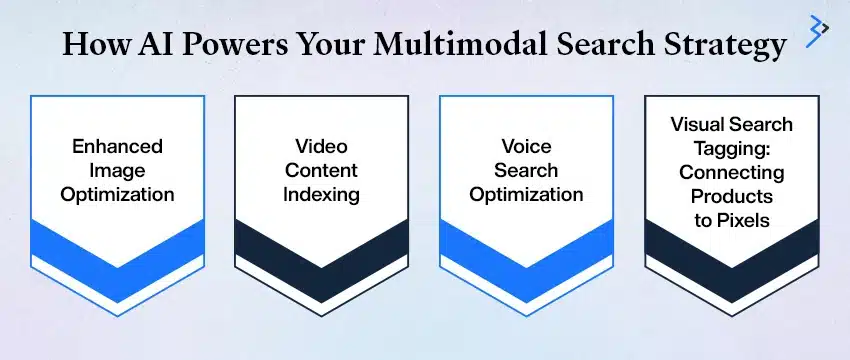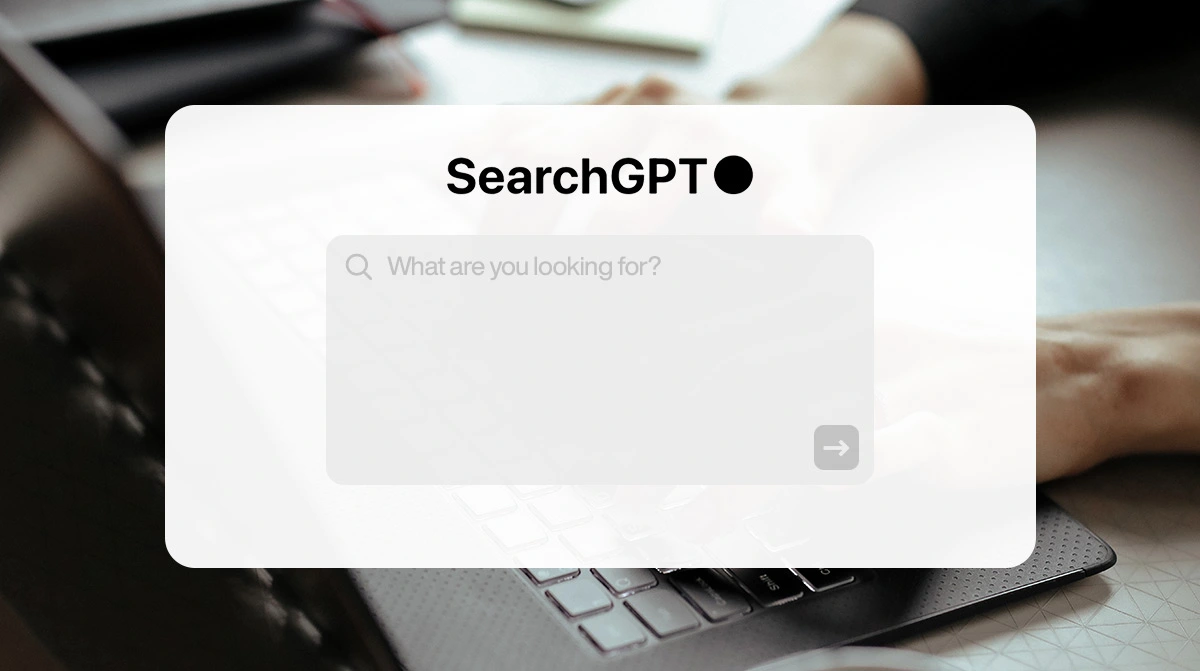Remember the good old days of search? You’d type a few keywords into Google, hit Enter, and scroll through pages of blue links. Simple, right? Well, those days are quickly becoming a relic of the past. The way people search for information, products, and services online is evolving, and it’s getting far more interesting – and visual and vocal!
We’ve all experienced firsthand how search engines, especially Google, are getting smarter. They’re not just reading words anymore; they’re seeing images, listening to voices, and even understanding what you’re looking at through your phone camera. This big shift is called Multimodal Search, and it means combining different “modes” (like text, images, video, and voice) to understand what you’re truly looking for.
Why is this happening? Because AI, especially when powered by robust Artificial Intelligence Development Services, is becoming incredibly powerful. Google’s advanced AI, running behind the scenes, can now process and understand information in ways that were once science fiction. This means your website’s success isn’t just about the words on the page anymore. It’s about how well your entire online presence – including your images, videos, and even the sound of your content – is optimized for these new ways people are searching.
If you want your business to be easily found online in this exciting new era, you need to understand multimodal search. And trust us, you want AI on your side.
In this guide, we’ll break down what multimodal search means, how AI is helping us adapt, and what you can do now to ensure your website doesn’t get left behind in this visual and vocal revolution. Let’s make sure your content is ready to be seen, heard, and discovered!
The Big Shift: Why Search Isn’t Just Text Anymore
Think about how you search today. You might:
- Snap a picture of a plant to identify it with a reverse image search.
- Ask your smart speaker, “Hey Google, where’s the nearest coffee shop?”
- Watch a YouTube video to learn “how to fix a leaky faucet”
- Scroll through Pinterest for outfit ideas, then click on an image to find similar clothes
These are all examples of multimodal search in action. Google and other platforms are building powerful AI tools that bridge the gap between different types of information. It’s about providing users with the most relevant answer, regardless of how they phrase the question.
Why the change? Two big reasons:
- User Convenience: It’s often easier and faster to show, say, or look at something than to type out a complex query.
- AI Advancements: AI has become so proficient at understanding various types of data (images, audio, and video) that it can now connect them to your search intent, providing richer and more accurate results.
This isn’t just a niche trend. Google reported that people used Lens for nearly 20 billion visual searches in October 2024, with 20% of these searches being related to shopping.
Meanwhile, over 8.4 billion voice assistants are in use globally, with around 20.5% of people worldwide actively using voice search, according to Demandsage. The numbers clearly show that people are searching beyond text.
How AI Powers Your Multimodal Search Strategy

So, how does AI actually help you get found in this new multimodal world? It acts as your super-smart assistant, helping search engines understand your content in ways they never could before. Let’s break down the key areas:
Infographic Idea:
A circular wheel with “Multimodal Search” at the center. Spokes radiate out to four key segments: Image, Video, Voice, Visual. Each segment has a small icon and a brief, compelling statement on how AI helps.
Infographic Content:
- (Center) MULTIMODAL SEARCH
- (Segment 1)
Images: AI Sees Your Pictures Better
AI generates smart alt text & compresses images for faster, more visible content.
- (Segment 2)
Videos: AI Hears Your Video’s Story
AI transcribes, chapters, and understands video content, making it fully searchable.
- (Segment 3)
Voice: AI Understands How You Speak
AI optimizes for natural language queries & helps you rank for voice answers.
- (Segment 4)
Visual: AI Connects What You See to What You Buy
AI tags products & boosts discovery on visual search platforms like Google Lens.
01 | Enhanced Image Optimization: Making Your Pictures “Seen” by Search Engines
We all know images are vital for engagement. However, for an SEO agency, they need to be more than just visually appealing. They need to be understood by search engines. This is where AI shines.
The Old Way: You’d manually write “alt text” (descriptions for images) and filenames, hoping you captured the essence. This was time-consuming and often generic.
The AI Way:
- AI tools can now analyze an image and automatically generate highly descriptive, keyword-rich alt text and captions. They can identify objects, colors, styles, and even emotions within an image.
- Besides that, AI-powered tools can be helpful for reverse image search, which can help you check how and where your image appears online or how similar image assets perform online.
Example: Instead of manually writing “blue shirt” for an image, an AI tool might suggest “men’s casual slim-fit blue linen shirt for summer outdoor wear.” This is far more helpful for search engines and for users with visual impairments who rely on screen readers.
- Image Compression: Large images can slow down your website, which negatively impacts your search ranking and user experience. AI-powered compression tools reduce file sizes without sacrificing quality. They intelligently identify redundant data in an image and remove it, making your site faster.
Site speed is a critical ranking factor. Multiple studies have shown that slow loading times can lead to a 50% bounce rate if a page takes more than three seconds to load. AI helps keep your images light and your site fast.
- Structured Data (Schema Markup): This is code that you add to your website to provide search engines with more context. For images, AI can automatically suggest and implement schema markup, helping your images appear in rich search results, such as Google’s image carousels.
For a product, such AI can help tag it with specific product schema, such as brand, price, availability, and reviews, making it much more likely to appear when someone is searching for that exact item.
- Why it matters: According to Analyzify, 50% of online shoppers say images helped them decide what to buy. By optimizing your images with AI, you’re not just making them discoverable; you’re making them shoppable.
Read More – AI-Powered Enhancements: How Shopify’s AI Revolution is Transforming eCommerce
02 | Video Content Indexing: Turning Your Videos into Searchable Gold
Video is king! But how do search engines “watch” your videos? They don’t. They rely on text. AI is bridging this gap, making your video content fully searchable and accessible.
The Old Way: You’d write a basic title and description, maybe add a few tags, and hope for the best.
The AI Way:
- Automatic Transcriptions & Captions: AI can automatically convert spoken words in your videos into text transcripts and captions. This text is then indexed by search engines, making your video searchable for specific phrases mentioned within it. It also vastly improves accessibility.
- Topic & Entity Recognition: Advanced AI can analyze video content to identify key issues, objects, people, and even sentiments. This allows search engines to understand the video’s content much deeper than just its title.
Example: If you have a video demonstrating “how to bake a sourdough bread,” AI can detect mentions of “starter,” “kneading techniques,” and “oven temperature,” and recognize images of “bread ingredients,” “oven,” and “dough.” This allows Google to show your video for specific search queries, such as “sourdough kneading tips,” even if that exact phrase isn’t in your title.
- Chaptering & Key Moments: AI can automatically identify key moments in a video and create chapters, allowing users (and search engines) to jump directly to the most relevant sections. This is crucial for long-form content.
- Video Sitemaps: Similar to XML sitemaps for web pages, AI can help generate and update video sitemaps, which inform search engines about all the video content on your site, enabling them to crawl and index it more efficiently.
- Why it matters: Video now makes up a considerable portion of internet traffic. Synthesia.io reported that video comprised 82% of all internet traffic, and over 2.6 billion people used YouTube monthly in 2022. By 2025, 96% of people watched an explainer video to learn about a product or service. If your videos aren’t optimized, you’re missing out on a massive audience.

03 | Voice Search Optimization: Speaking the Search Engine’s Language
“Hey Google, find me a vegan restaurant near me.” Voice search is no longer a gimmick; it has become a daily habit for millions. It’s especially popular for local searches and quick questions.
The Old Way: Traditional SEO focused on short, typed keywords. Voice search queries are long, conversational, and often phrased as questions.
The AI Way:
- Conversational Keyword Research: AI tools are crucial for identifying longer, more natural “long-tail keywords” and question phrases that people use when interacting with their devices. They can analyze voice search data patterns to uncover common questions related to your business.
- Content for Featured Snippets: Voice assistants frequently pull answers directly from Google’s Featured Snippets (the quick answer boxes at the top of search results). AI helps you structure your content to be “snippet-ready” by providing clear, concise answers to common questions.
Digital Silk noted that over 40% of all voice search answers are pulled from a featured snippet on Google. This is often referred to as “Position Zero” and is considered prime real estate.
- Question-and-Answer Formats: AI can help generate comprehensive FAQ sections that directly answer common voice queries, ensuring your content is seen as authoritative and helpful by search engines.
- Local SEO Boost: Many voice searches have local intent (e.g., “bakery open now”). AI helps optimize your Google Business Profile and local listings with accurate, comprehensive information, making you more discoverable for “near me” voice searches.
- Why it matters: Digital Silk also reported that 32% of consumers use voice daily to perform searches they’d normally type. The average voice search query is 29 words long, highlighting the conversational nature. Optimizing for voice is about meeting your audience where they are.
04 | Visual Search Tagging: Connecting Products to Pixels
Imagine seeing a cool pair of shoes on a friend and snapping a picture to find out where to buy them. That’s visual search, and it’s becoming a game-changer for e-commerce and product discovery, fundamentally reshaping how eCommerce website and app development services approach user experience. Platforms like Google Lens, Pinterest Lens, and even some online store apps utilize this.
The Old Way: You’d upload product images and maybe add a general category. It was hard for systems to “see” the specific details.
The AI Way:
- Automated Product Tagging: AI image recognition can automatically identify and tag specific features within an image – a “floral pattern,” “high-waisted,” “leather texture,” “vintage style,” or even the “brand logo.” This means your product can be found even if a user searches for a specific visual characteristic they don’t know the name for.
- Category and Attribute Assignment: AI helps assign images to relevant product categories and add specific attributes (e.g., color, material, style) that improve search accuracy.
- Inventory Discoverability: For businesses with large product catalogs, AI can dramatically improve how easily new and existing inventory is discovered through visual cues.
Example: A user uploads a picture of a uniquely shaped handbag. AI can identify the “trapeze shape,” “gold hardware,” and “quilted leather” and then show the user similar bags from your inventory, even if they don’t know these specific terms.
- Pinterest Lens Integration: Pinterest is a visual search powerhouse. AI tools can help optimize your Pins and product catalogs for Pinterest Lens, driving traffic from visual discovery to your e-commerce site.
- Why it matters: According to AdLift, the global visual search market is projected to be valued at $150.43 billion by 2032. Further, MageComp reports that 62% of online shoppers purchase products they see via visual search. If you sell products, making them visually searchable is non-negotiable for future growth and success.
Read More – More Than Just Suggestions: How AI Is Deepening Customer Connections in eCommerce
Getting Started: Your Multimodal Search Checklist

Don’t feel overwhelmed! Integrating multimodal search optimization into your SEO strategy is a journey, not a sprint. Here’s a practical checklist to begin:
Your Multimodal SEO Action Plan
| Area | Action Steps with AI Help | Tools/Concepts to Explore |
| Image Optimization | – Audit existing images for missing/poor alt text. – Use AI tools to generate descriptive alt text and captions. – Implement AI-powered image compression. – Add relevant image schema markup. | TinyPNG, Kraken.io, Imagify, Image SEO (WordPress plugin), AI-driven DAM systems |
| Video Optimization | – Ensure all videos have accurate, AI-generated transcripts and captions. – Optimize video titles, descriptions, and tags. – Use AI to identify key moments for chaptering. – Submit video sitemaps. | YouTube’s automatic captions, VidIQ, TubeBuddy, dedicated video indexing tools (e.g., VIDIZMO) |
| Voice Search Prep | – Research conversational long-tail keywords and question phrases using AI tools. – Create detailed FAQ pages addressing common queries. – Structure content for featured snippets. – Optimize your Google Business Profile. | AI keyword tools (e.g., SEMrush, Ahrefs with AI features), AnswerThePublic, AlsoAsked, ChatGPT/Gemini for content ideas |
| Visual Search Prep | – Ensure all product images are high-resolution and from multiple angles. – Use AI for automated product tagging and attribute assignment. – Integrate with platforms like Google Lens and Pinterest Lens. | Google Lens integration, Pinterest Business tools, AI-powered visual search platforms (e.g., ViSenze, Adobe Sensei) |
| General Strategy | – Analyze your current search traffic for non-text queries. – Educate your team on multimodal search principles. – Regularly monitor new AI developments in search. | Google Analytics 4, Google Search Console, Industry news & webinars |
The Future is Multimodal: Don’t Get Left Behind
The digital landscape is constantly shifting, and search is at the forefront of this change. Relying solely on old-school keyword stuffing and text-only content is like trying to navigate a smartphone with a rotary dial. Google and other search engines are investing heavily in AI to deliver a more intuitive, human-like search experience.
This isn’t just about technical tweaks; it’s about a fundamental shift in how we approach online visibility. It means thinking beyond words to consider how your brand, products, and services can be discovered through images, videos, and even spoken queries.
For businesses in North America and beyond, embracing multimodal search optimization powered by AI isn’t just an option – it’s a necessity for future growth. By preparing your content for these new search methods, you’re not just optimizing for today; You’re future-proofing your digital presence with expert digital marketing services and ensuring your business shines brightly in a competitive online landscape. Regardless of how users choose to find you.
Start experimenting, keep learning, and leverage AI as your guide. The world of search is becoming increasingly intelligent, and so can your business.
Frequently Asked Questions (FAQs)
Multimodal search means searching for information online using more than just typed words. It includes using images (like with Google Lens), speaking into your device (voice search), or even watching videos to find answers. It’s about combining different “senses” or “modes” to search for what you need.
AI is the brain behind multimodal search. It helps search engines understand content across different formats. For example, AI can “see” what’s in an image and describe it, “listen” to a video and transcribe it, or understand the natural, conversational language of a voice query. This allows your content to be found regardless of how someone searches.
Yes, voice search is very popular! Over 8.4 billion voice assistants are in use globally, and many people use them daily for quick questions or local searches. To optimize, focus on natural, conversational language, create content that answers common questions directly (like FAQs), and aim for Google’s “Featured Snippets” as voice assistants often pull answers from there.
AI can significantly enhance your image SEO. It can automatically generate detailed “alt text” (descriptions for images that search engines read), compress images to make your website faster, and help add “structured data” so search engines understand your images better. This makes your images more discoverable in Google Images and visual search tools like Google Lens.
You don’t always need to start from scratch! While creating new video or visual content can be beneficial, much of multimodal optimization involves enhancing your existing content. For example, adding AI-generated transcripts to old videos, improving alt text on existing images, and restructuring text content to answer common questions for voice search. AI tools can help adapt your current assets.
Related Articles
-
3 Ways Machine Learning is Making a Difference in the Healthcare Industry
The IT industry is constantly on the lookout for improvements and innovations in any of the codes that the developers write down on a daily basis. Improvements and innovations consume
-
AI Impact On Medical Diagnostics And Treatment
The medical industry has witnessed a significant transformation due to the remarkable impact of Artificial Intelligence (AI). When doctors successfully save a patient’s life, they are elevated to a status
-
Guide on SearchGPT: AI-Based Search Feature
Introduction The concept of organic search isn’t new to business owners! Over the last two decades, Search Engine Optimization (SEO) has driven organic visibility for brands and businesses worldwide. Nearly




